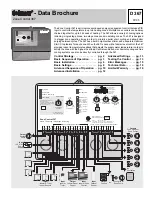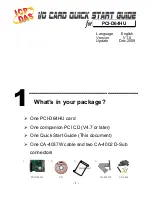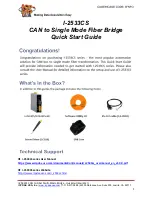
5
Fast Acting Zone Valves or Zone Pumps
If the
Thermal Motor DIP switch is set to Off, the 367 assumes that fast acting zone valves
or zone pumps are connected to the zone relays. The system pump and
Heat Required
light are therefore turned on as soon as the first zone relay is operated. One minute before
the last zone relay is turned off, the 367 purges the boiler by turning the
Heat Required
light off and keeping the system pump operating.
Slow Acting Zone Valves with Thermal Motors
When the DIP switch is set to
Thermal Motor, the 367 assumes that slow acting zone
valves with thermal actuating motors are connected to the zone relays. With slow acting
zone valves, the 367 allows a 3 minute period for the first zone valve to open before the
system pump and
Heat Required light are turned on. The total operating time for the zone
relays is also increased by an extra 2 minutes. This helps compensate for the longer
opening versus closing time of the slow acting zone valves. For one minute after the last
zone relay is turned off, the 367 purges the boiler by turning the
Heat Required light off
and keeping the system pump operating.
COOLING OPERATION
When the DIP switch on the 367 is set to
Zone 1 Cooling, output relay 1 can either be used
to enable an auxiliary cooling control system or to directly operate a central cooling unit.
Cooling Control (RTU is present)
If
Zone 1 Cooling is selected and an RTU or Indoor Sensor is connected to terminals Com
Sen — RTU 1 (5 & 6), the 367 can directly control a central mechanical cooling system
using output relay
1. If an RTU is used, the desired indoor temperature is set using the
RTU dial down to 73
°
F (23
°
C), but if an Indoor Sensor is used, the desired indoor
temperature is fixed at 77
°
F (25
°
C). Output relay
1 is allowed to turn on once the heating
zones connected to the 367 have been satisfied for at least 45 minutes, and is turned off
whenever any zone requires heat. The 367 varies the on time of output relay
1 over a 30
minute period. As the cooling load increases, the on time of the output relay increases.
In order to prevent short cycling, the 367 ensures that the output relay remains on or off
for at least 3 minutes.
Cooling Enable (No RTU)
If
Zone 1 Cooling is selected and there is no RTU or Indoor Sensor connected to terminals
Com Sen — RTU 1 (5 & 6), the 367 can enable an auxiliary cooling control through output
relay
1. Output relay 1 is turned on once the heating zones connected to the 367 have
been satisfied for at least 45 minutes, and is turned off whenever any zone requires heat.
UNOCCUPIED (NIGHT SETBACK)
The 367 can be switched into UnOccupied mode through the built in 24 hr. Timer or by
closing an external switch or timer relay wired between the terminals
UnO Sw — Com Sen
(14 & 16) on the control.
24 hr. Timer
The 367 has a built in 24 hr. Timer which can be used to set a single UnOccupied event
during a 24 hour period. The 24 hr. Timer is activated by pushing the
Start button at the
desired starting time for the UnOccupied period. The duration of the UnOccupied period
is set using the
UnOccupied Duration dial. Once the Start button is pushed, the Timer
Active light is turned on and the 367 enters the UnOccupied mode each day at the same
starting time. The 24 hr. Timer can be deactivated by pressing the
Start button again. A
new UnOccupied period starting time can be selected by repeating the above procedure.
Note If an external switch is closed between the terminals
UnO Sw — Com Sen
(14 & 16), the 24 hr. Timer is disabled. An external UnOccupied switch and the 24
hr. Timer should not be used at the same time.
UnOccupied Switch Input
A switch or external timer with a dry relay contact output can be wired between the
terminals
UnO Sw — Com Sen (14 & 16) on the 367. When the switch or relay contact
is closed, the 367 registers an UnOccupied signal. A tekmar Timer 031 is available which
can be programmed to provide individual UnOccupied schedules for each day of the week
with up to two separate UnOccupied events per day. For more information on the Timer
031 see the Data Brochure D 031.
Zone 1 Cooling
Fast acting
zone valve
or zone pump
Off
Thermal Motor
Slow acting
zone valve
Off
Thermal Motor
C
Cooling Control
RTU
Com
1-2
19
1
20
2
21
Com
Sen
5
6
RTU
1
RTU
2
7
C
Cooling Enable
No RTU
Com
1-2
19
1
20
2
21
Com
Sen
5
6
RTU
1
RTU
2
7
SCHD
Su
T I M E
AMPM
UNOCC
OVR
Sa
Mo
WeTh Fr
Tu
1
2
Zo
Out
15
14
UnO
Sw
Com
Sen
16
Occupied
Optimum Start / Stop
UnOccupied
Timer Active
24 hr. Timer
0
12 hrs.
24
6
18
• Dial the desired duration of the
UnOccupied period.
• Press start button at the time of day
you want the UnOcc. period to begin.
Timer Active light turns on.
Start
UnOccupied
Duration
0 = always Occupied
24 = always UnOccupied


































